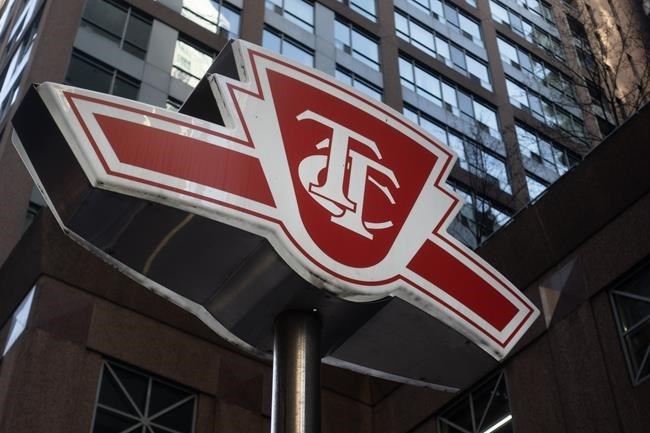TORONTO — Before Industry Minister François-Philippe Champagne ruled Rogers Communications Inc. must grant its rivals access to its cellular network on Toronto's subway, the company had urged Ottawa not to force it to turn off access for its own customers, newly released documents reveal.
In an Aug. 28 filing to Innovation, Science and Economic Development (ISED) Canada, the Toronto-based telecommunications company said "taking service away from any customer is clearly not in the public interest, nor is constraining the public safety benefits for all wireless consumers and transit riders."
The comments were part of the second phase of Champagne's consultation process meant to expedite negotiations between the four major carriers on ensuring wireless access for all TTC subway riders.
The telecoms' final submissions in that process were posted to ISED's website last Friday — four days after Champagne announced new licence conditions requiring Rogers to provide BCE Inc. and Telus Corp. immediate access to the subway's cellular infrastructure and share technical details.
The minister set a deadline of Oct. 3 for all passengers on the TTC subway system to have cellular connectivity, regardless of their carrier.
In their initial filings to the department, Bell and Telus advocated that Champagne prevent Rogers from giving its own customers first access to the upgraded 5G network it had partially built in subway stations and tunnels until it is technically feasible for all riders to use the mobile network.
Rogers opposed that potential restriction, which had been floated by Champagne when he announced the consultation, instead saying it preferred that Ottawa leave the timing of access to commercial negotiations.
But rather than waiting for Champagne to rule on the issue, Rogers unexpectedly rolled out high-speed 5G wireless service to its own customers in core parts of the downtown subway network on Aug. 23 — five days before the deadline for reply comments in the federal review.
In its final submission, Rogers called Bell and Telus' arguments "self-serving," saying they required that Ottawa "take away service from some customers and negatively impact public safety following the launch" of its partial 5G network.
"There is mischief in their comments; they are harmful to the public interest and, if accepted, would reward Bell and Telus for their tactics," Rogers said in its filing.
In their own submissions, Bell and Telus slammed the late-August launch, with the latter also taking aim at Rogers' accompanied promotional campaign, which included advertisements on the subway itself.
Telus said the ads "serve as evidence of Rogers’ deliberate, co-ordinated intention to introduce their services while regulatory proceedings before ISED and the CRTC are still in progress, demonstrating a complete disregard for these processes."
"Rogers now has a head start in the TTC subway," it said. "Rogers is benefiting from its subversion and delay tactics that it has employed since it acquired BAI Communications Inc."
Champagne's Sept. 11 ruling meant Rogers will not have to shut off cellular service on subway platforms and tunnels, despite its own customers getting first access. Instead, the company was given roughly three weeks to bring some level of coverage for all riders, a decision that was welcomed by all three telecoms.
The minister also set a Dec. 20 deadline for the carriers to negotiate commercial agreements to provide service on the subway over the long term.
The aim of those negotiations will be to solve the ongoing deadlock between Rogers, Bell and Telus over the ideal technical approach, and associated financial terms, for providing coverage to all subway riders.
Bell and Telus both want a joint build of the subway's 5G network using a consortium model similar to that of Montreal's Metro system, rather than a pay-for-access approach. Rogers has not publicly committed to either model.
Rogers bought the Canadian arm of BAI Communications, which had owned the rights to provide wireless service on the subway, in April. It then announced plans to upgrade the existing infrastructure installed by BAI at most downtown subway stations and build 5G capability for the entire network of stations and tunnels — a process it expects to take two years.
Rogers vowed to make the system accessible for other carriers to provide coverage to their customers. That includes honouring BAI's previous contract with Freedom Mobile, now owned by Quebecor Inc., the lone carrier whose customers already have access to the network.
Quebecor has largely supported Rogers' position amid the standoff.
In its Aug. 28 submission to Ottawa, Bell said the consortium model is "a clear alternative to giving one carrier monopoly control of a public good, such as wireless connectivity in a subway system."
"Such a model fully compensates Rogers for all of the costs it has or will incur (including the costs of its acquisition of BAI Canada), but puts the safety and comfort of Canadians ahead of Rogers' attempts to extract private monopoly profits from a public good," it said.
While the Oct. 3 deadline covers only the existing network, Ottawa is requiring service be in place for all stations within six months of the commercial agreements being reached. Service will need to be in place for 80 per cent of tunnels within two years, and full system coverage by the end of 2026.
This report by The Canadian Press was first published Sept. 18, 2023.
Companies in this story: (TSX:RCI.B, TSX:BCE, TSX:T, TSX:QBR.B)
Sammy Hudes, The Canadian Press

